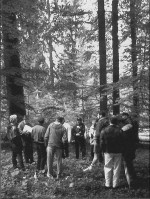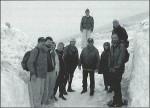International LTER (ILTER) Interactions
Following the NSF International Programs-supported visit of a team of seven U.S. LTER representatives to Central Europe in June 1995, a group of 11 scientists from Poland and the Czech and Slovak republics visited the United States in September 1995. First stop was at NSF for an overview of the U.S. LTER Program and International Programs (TNT) opportunities for research exchanges.While each participating country develops core support for their own research programs, TNT will fund efforts that facilitate interaction and communication. Proposals from other countries are submitted to their counterpart funding agencies, and U.S. companion proposals either to a regular program (for direct research support plus travel from TNT) or to TNT for travel funds. U.S. scientists who already receive NSF funding may be eligible for travel and collaboration supplements.
The visitors provided an overview of research in their respective countries, noting that the short-term nature of funding makes it difficult to develop the comprehensive, integrated long-term efforts. While sites may be well- characterized, more advanced technologies (GIS, remote sensing, modern weather stations) are needed for comparability. The group was divided into three focus groups for U.S. LTER site visits:
- Biogeochemistry and forest ecology -- Hubbard Brook and Coweeta LTER sites. Chris Johnson (Hubbard. Brook/Syracuse University) and Steve Macko (Virginia Coast/University of Virginia), leaders
- Hydrobiology in lakes and streams -- North Temperate Lakes and Coweeta LTER sites. Fred Benfield (Coweeta/Virginia Polytech Institute), leader
- Montane and alpine systems -- Sevilleta and Niwot Ridge LTER sites. James Gosz (Sevilleta/University of New Mexico), leader
The Czech scientists met near the end of the tour to plan for an LTER effort. They formed a committee, elected a chair (Vera Straskrabova, Director, Institute of Hydrobiology, Czech Academy of Sciences), and identified six sites:
- Krivoklatsko (Krivoklat area)
- Krkonose (Giant Mountains)
- Palava hills
- Sumava (Bohemian Forest Mountains)
- Trebonsko (Trebon area)
- Vltava watershed reservoirs
The U.S. LTER Network Office agreed to help identify funding for training assistance in connectivity and data information management, and to help develop and initially host a Czech WWW home page.

 Enlarge this image
Enlarge this image
